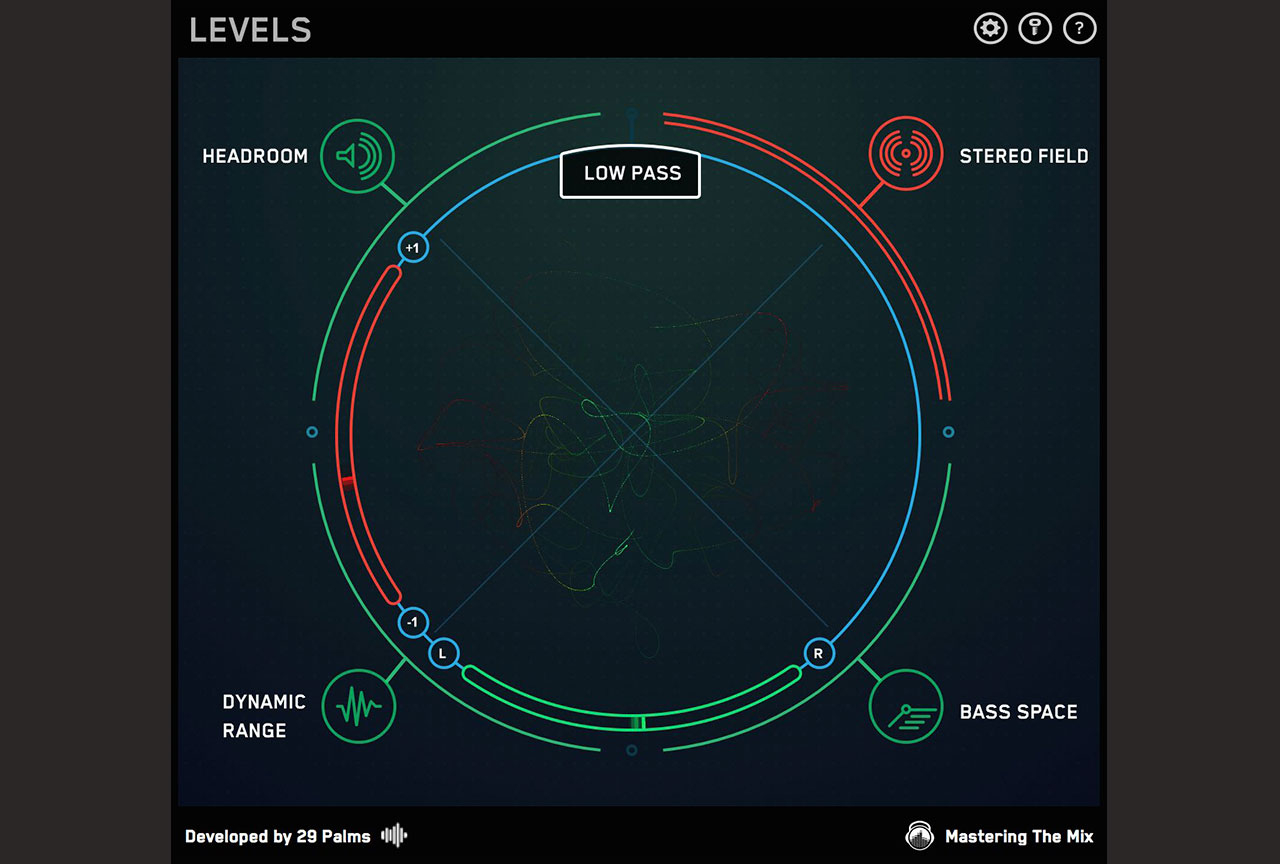- Born out of repetitive strain with clients, LEVELS is the brainchild of Tom Frampton and the coding engineers 29 Palms. He'd always have to repeat himself when giving clients feedback on the flaws of their mix so he decided to create a plug-in that modernised the way we look at mixing music. Instead of leaving the beginner to source and interpret their own metering, Frampton created a plug-in that supposedly addresses the core issues of a mix in a transparent fashion.
LEVELS covers five key elements: mono compatibility, headroom, stereo imaging, dynamic range and bass space. LEVELS' interface is a circle with four sections representing characteristics of the mix, with a mono switch up top. If the signal passing through the plug-in doesn't meet the criteria of one of the elements, it'll light up red. If you click each section, you'll learn its status and why your mix isn't cutting it in any respective field.
The mono compatibility switch is self-explanatory and common in most DAWs, though LEVELS allows you to listen to your mix through a single speaker by muting the other to avoid any potential low-end hype. Headroom is the first main section with two further readings: dBFS and LUFS. dBFS is a peak-style measurement that will tell you the volume of your track's peaks. 0dBFS is the absolute maximum a digital signal can reach before it clips but hitting it exactly introduces its own problems. LEVELS recommends a goal of -6dB for your mix in order to give the mastering engineer plenty of room to apply EQ and compression. If your mix crosses the -6dBFS threshold, the section lights up red. While it's useful for the user to have a guide of what's appropriate in terms of levelling, it can be slightly misleading to suggest -6dFS will give a mastering engineer room to work. After all, you could simply run an extremely compressed track through a gain plug-in before it reaches LEVELS, reducing the volume until it lights up green again. The dynamic range is much more important to consider. It should be pointed out that you can change the default -6dBFS threshold but it can be a misleading figure.
In comparison, LUFS is a more modern and standardised version of RMS. It takes an average of the loudness of a piece of audio rather than measuring potentially drastic peaks or drops in level. LUFS differs from RMS in that it uses clever filtering to distinguish between the frequencies the ear is most sensitive to, making it an even more accurate read-out of perceived loudness. Generally a level between -12 and -8 will be suitable for electronic music.
Assuming you've satisfied the headroom criteria, you can move on to stereo field. If you've used stereo metering before, you'll recognise what's on offer. The familiar vectorscope displays a straight line if your signal is in mono and a more spread out visual when the signal is wider. Using other plug-ins, it could be hard to tell when wide meant too wide but LEVELS will light up red when your mix has drifted too far in one direction. I was able to force the test signal out of phase using Ableton's Simple Delay and true enough, certain settings made the icon light red. It proved very handy when using the Haas effect.
The bass space meter is a simple way of identifying if any elements of your mix are creating any potentially harmful low frequencies. Muting the bass and kick before you start, it'll tell you if any sounds are leaking into the sub of your track. You can do something similar with a frequency analyser but it's an important test all the same.
Dynamic range complements the headroom section. Using a DR reading, the plug-in measures the immediate peaks and troughs of a signal and outputs a figure accordingly. The lower the number, the less dynamic range your track has,—usually that's a bad thing. It's set to 12DR by default, which can be changed in the settings. For electronic music, you'll want to set this to be slightly lower. Dance music tends to deal with more consistent levels, even before you consider compression, but checking your mix against a more general standard can be helpful.
While LEVELS doesn't eradicate the need for traditional metering, it certainly simplifies the process in a single window. I found the immediate need to customise its thresholds slightly counter-intuitive—the plug-in is aimed at beginners and this could leave them in the dark. Meters are supposed to be impartial and scientific but LEVELS treads a fine line with taste and opinion, which could potentially confuse users. As with all metering and analysis, it only ever tells one part of the story and LEVELS can't help you when it comes to elements of creativity that could breach its static rules. For £69, it's a safe bet for as a quick reference but it's no production Swiss army knife.
Ratings /
Cost: 3.8
Ease of use: 3.5
Versatility: 3.7
